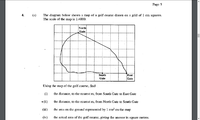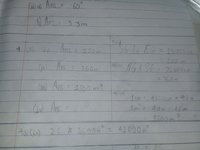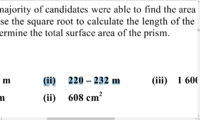Basic geometry :l ( every mark counts ) :l
- Thread starter Denzel
- Start date
Otis
Elite Member
- Joined
- Apr 22, 2015
- Messages
- 4,592
They should not ask for the "actual area" of the golf course. (There's no way to determine that from their sketch.)
What they want is an estimate. This is why they gave a range of areas, for the answer. By the way, you typed the number 4,160,00 as the low number in their range. If that's what they wrote, then it's wrong. I'm thinking it's supposed to be 41,600.
If so, then your answer is in their range and it's fine.
How did you count a total of 26 squares? I would have printed the grid on paper and used scissors and tape.
PS: I don't like seeing statements like 1 m^2 = 1600 m^2, but I know what you're trying to say.
?
What they want is an estimate. This is why they gave a range of areas, for the answer. By the way, you typed the number 4,160,00 as the low number in their range. If that's what they wrote, then it's wrong. I'm thinking it's supposed to be 41,600.
If so, then your answer is in their range and it's fine.
How did you count a total of 26 squares? I would have printed the grid on paper and used scissors and tape.
PS: I don't like seeing statements like 1 m^2 = 1600 m^2, but I know what you're trying to say.
?
Oh. Alright then. Thank you. I counted the whole squares and estimated the others, using .75, .45 etc writing them on a paper. Then I added the numbers together.They should not ask for the "actual area" of the golf course. (There's no way to determine that from their sketch.)
What they want is an estimate. This is why they gave a range of areas, for the answer. By the way, you typed the number 4,160,00 as the low number in their answer. If that's what they wrote, then it's wrong. I'm thinking it's supposed to be 41,600.
If so, then your answer is in their range, so it's fine. How did you count a total of 26 squares? I would have printed the grid on paper and used scissors and tape.
?
I'd also recommend revisiting part (ii), as you got that answer wrong. You said that the distance between the North Gate and the South Gate is 3600 m2 which means that that distance would be represented by 9 squares on the grid. But how did you come to that conclusion? Even using the naive (and incorrect) approach of saying that you have to go 5 squares down and 3 squares to the right, that produces a "distance" of 8 squares, not 9.
If you label the bottom left corner of the grid (0,0), then the coordinates of North Gate are (3, 6) and the coordinates of the South Gate are (6, 1). What does the distance formula indicate about the distance between these two points? Can you see why it must be less than 8 squares, because travelling along the diagonal must be a shorter path than walking the two straight lines?
Regarding the area of the shape, one way of generating a crude estimate is to count the number of whole squares inside the shape, then add an additional one-half square for any square where any portion is inside the square (so even the two squares on the left side that only a sliver is inside the shape would still count as 1/2 each). Doing this shows there are 17 whole squares and 18 half-squares, giving an estimate of the area as 26 squares. The reason this estimate works reasonably well is because it over-estimates the area of the squares where only a sliver is inside, but under-estimates the area of the squares that are almost fully contained within the shape, and in the end these errors roughly cancel out.
If you label the bottom left corner of the grid (0,0), then the coordinates of North Gate are (3, 6) and the coordinates of the South Gate are (6, 1). What does the distance formula indicate about the distance between these two points? Can you see why it must be less than 8 squares, because travelling along the diagonal must be a shorter path than walking the two straight lines?
Regarding the area of the shape, one way of generating a crude estimate is to count the number of whole squares inside the shape, then add an additional one-half square for any square where any portion is inside the square (so even the two squares on the left side that only a sliver is inside the shape would still count as 1/2 each). Doing this shows there are 17 whole squares and 18 half-squares, giving an estimate of the area as 26 squares. The reason this estimate works reasonably well is because it over-estimates the area of the squares where only a sliver is inside, but under-estimates the area of the squares that are almost fully contained within the shape, and in the end these errors roughly cancel out.
360m not 3600m² but yes, wrong none the less. Just 4) (a) (ii) is definitely wrong. 4). (a) (i) is correct. So I used the distance formula and calculated the Ans. = 232m Thank you.
Attachments
Last edited:
Shouldn't the distance (after rounding to the nearest meter) be 233 meters? The distance between the two points on the grid is given by 52+32cm=34cm. Then, accounting for the scale, the real world distance should be 400034cm≈23323.8076cm≈233m.
Hmm I calculated √34 = 5.8 approx. Then 5.8 × 40m = 232 mShouldn't the distance (after rounding to the nearest meter) be 233 meters? The distance between the two points on the grid is given by 52+32cm=34cm. Then, accounting for the scale, the real world distance should be 400034cm≈23323.8076cm≈233m.
Otis
Elite Member
- Joined
- Apr 22, 2015
- Messages
- 4,592
This is known as 'roundoff error'. Wait until the final answer to round. When we round intermediate results, we introduce a little bit of error. The more previous steps we round, the greater the chance that our final answer will be wrong.… I calculated √34 = 5.8 approx. Then 5.8 × 40m = 232 m
? When using a calculator from one step to another, I carry over all the digits displayed for the next step. That is, I don't re-enter the calculator result, for use in the next calculation; I let the machine recall it. In situations where I need to round intermediate results (eg: doing arithmetic by hand, using a calculator without memory features, using a result from several steps prior), then I first consider how many digits I've been told to report (for my final answer) and I round any intermediate results to at least two places more than I need to report. This prevents roundoff error, when I round my final answer.
Cheers ?



